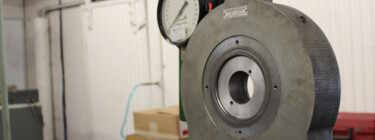Torque is a difficult value to calculate accurately, especially for construction fasteners and should be used cautiously. The primary challenge is accounting for environmental factors, coatings, and a number of other variables including surface texture, material hardness, and thread series. In most situations, it is challenging to give reliable allowable torque values for bolted assemblies. For the most accurate data we recommend field testing the intended assemblies using a calibrated torque wrench and a Skidmore-Wilhelm load indicating device to equate actual torque to the desired tension.
The theoretical torque values listed on our site are intended as reference point. This chart only covers products with a published friction coefficient.

Wayne, torque is not lost when an extension is added between a torque wrench or power tool and the socket. More angle of rotation will be required to achieve a given torque when using an extension, but torque measured at the torque wrench or power tool will equal torque measured at the socket.
However, if tightening to a torque plus angle specification, the use of an extension will result in an angle measurement error and an extension is not recommended.
There seems to have some discrepencies in the bolt torq chart. For example, per your chart, the torq for plain 3/4 ASTM A325 bolt is 350-425 lbs*ft. Assuming that yield strength and proof stress is respectively 92ksi and 85ksi, a torq of 350 lbs-ft means a stress of 83717psi (clamp load of 28000 lbs on 0.334 in^2 surface and k=0,2), which is 91% of yield stress. However, in your chart notes, it is indicated that the clamp load is calculated to get 75% of minimal proof stress, which would be 0.75*85 = 63,75ksi. In other words, the chart seems to overtorq bolts by approx. 24%. Is this normal ?
@Frederic- Good catch. The difference is that A325 and A490 bolts are typically tensioned to higher levels than general purpose fasteners. The RCSC/AISC recommends tension values that exceed the 75% clamp load that we used for the other grades. The values that we base our torque numbers off of for A325/A490 bolts come directly from them, whereas the values for the other grades are general purpose estimates.
Very good technical publication. However, with the use of hydraulic torque equipment ( which, incidentally, I pioneered in the 1970’s ) being the tool of choice in the various process industries, you should address the importance of controlling the coefficient of friction when installing the threaded fasteners and BY ALL MEANS “lubricate the nut and washer faces in addition to the threads.” I was teaching and practicing this philosophy in the 1970’s and 1980’s and never had a leak on a pressure joint, except two times when the old hardware, which was over 10 years old had to be re-used when I was in Trinidad and Tobago at Petrotrin and the new bolts and nuts did not arrive until the turnaround was over. Today, it seems to be passe. Only the threads are being lubricated in most instances.
For the A193 B7 anchors, will a waxed ASTM A194 2H nut meet the requirements to specify a torque corresponding to the Galv+Wax column of the torque table.
If not what are the requirements of the wax to meeting these low torque values?
Is there any background/testing that was performed on wax nuts for determining the required torque value?
@Brian – Yes, a waxed A194 2H nut would meet that requirement. The values in those tables were calculated based on published friction and proofload numbers. We did not do extensive confirmation testing, but we did compare these values to some actual tests and, although they varied as expected, they did not drastically disagree with the published values.
Dear sir
If the threaded shaft 12mm diameter , 1.3mm threaded step then is how much tightening force ( the material is ABS plastic threaded shaft ) .
Thanks a lot
Congmai
@Congmai- I am sorry, but we do not have any information regarding plastic fasteners.